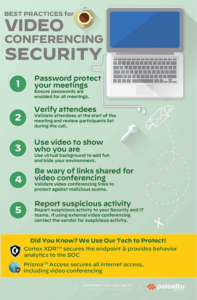
By Niall Browne, SVP and CISO at Palo Alto Networks
The surge in video conferencing use during these challenging times shows us the power of community and being connected digitally. Video conferencing lets us share what’s important to us in realtime and to solve problems together without having to be physically present in one location.
At Palo Alto Networks, we have embraced video conferencing to strengthen our channels for connecting with and supporting our customers, to transform how we lead and work together – and to protect our company from cybersecurity threats.
Video Conferencing Security Risks
Here are a few risks that we’ve observed to date, and how organizations can take steps to address them:
Meeting Bombing – In this type of attack, an uninvited guest joins a video conferencing meeting either to listen in on the conversation or to disrupt the meeting by sharing inappropriate media. These incidents are possible when:
Palo Alto Networks is helping customers create video conferencing Indicators of Compromise (IOCs). We have the ability to see threats ahead of the curve, and with the power of the cloud, we can instantly share this knowledge with our 70,000+ customers.
Many of our customers have proactively reached out to share security best practice stories and what has worked during these challenging times. This allows Palo Alto Networks the unique opportunity to help protect customer endpoints as well as video conferencing and internet traffic, using Cortex XDR and Prisma Access. This 360-degree security view of endpoints and traffic has been key to helping protect our customers against video conferencing threats, while ensuring that companies can continue to collaborate and maintain critical human contact as they rapidly scale a remote workforce.

